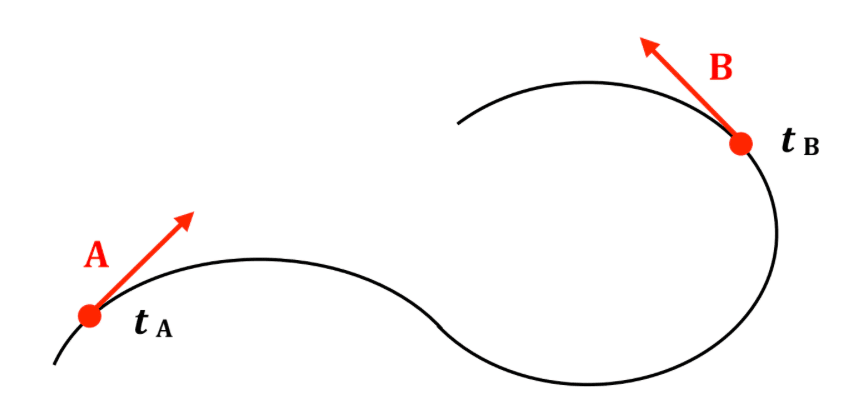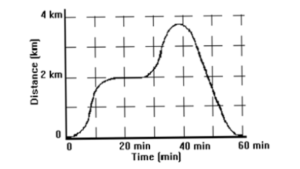# Part (a): What is the difference in the time the balls spend in the air?
| Step | Derivation/Formula | Reasoning |
|---|---|---|
| 1 | y = v_0 t + \frac{1}{2}gt^2 | Use the kinematic equation for vertical motion to find the time of flight of each ball. |
| 2 | 19.6 = 0 + 14.7t + \frac{1}{2}(9.8)t^2 | For the ball thrown downward: v_0 = -14.7 \, \text{m/s} , g = 9.8 \, \text{m/s}^2 |
| 3 | 19.6 = 14.7t + 4.9t^2 \Rightarrow 0 = 4.9t^2 + 14.7t – 19.6 | Solve the quadratic equation using the quadratic formula. |
| 4 | t = \frac{-14.7 \pm \sqrt{(14.7)^2 – 4(4.9)(-19.6)}}{2(4.9)} | The positive root is taken since time cannot be negative. |
| 5 | t = 1 \, \text{s} | Solving the quadratic equation gives t = 1 \, \text{s} . |
| 6 | y = v_0 t + \frac{1}{2}gt^2 | Now for the ball thrown upward: initial speed v_0 = 14.7 \, \text{m/s}</td> </tr> <tr> <td>7</td> <td>0 = 14.7t – \frac{1}{2}(9.8)t^2 \Rightarrow t(2.9 – 2.9t) = 0 \Rightarrow t = 3 \, \text{s}</td> <td>Solving for \( t when the ball reaches the top of its trajectory. |
| 8 | \text{Total time in air} = (2 \times 1 + 3)\ s = 5 \, \text{.} | The time the second ball spends in the air is double the ascent time plus the fall time. |
| 9 | Difference in time = 2 \, \text{s} – 1\,\text{s} = 1s | The difference in the time the balls spend in the air. |
# Part (b): What is the velocity of each ball as it strikes the ground?
| Step | Derivation/Formula | Reasoning |
|---|---|---|
| 1 | v = v_0 + gt | Use the first kinematic equation to find the final velocity. |
| 2 | v = -14.7 + 9.8 \times 1 = -24.5 \, \text{m/s} | For the ball thrown downward: add gravitational acceleration effect. |
| 3 | v = 14.7 – 9.8 \times 3 = -14.7 \, \text{m/s} | For the ball thrown upward: subtract the effect of gravity over fall time. |
# Part (c): How far apart are the balls 0.800 s after they are thrown?
| Step | Derivation/Formula | Reasoning |
|---|---|---|
| 1 | d_{downward} = v_0 t + \frac{1}{2}gt^2 | Use kinematic equation for the ball thrown downward. |
| 2 | d_{downward} = 14.7 \times 0.800 + \frac{1}{2} \times 9.8 \times 0.800^2 = 15.68 \, \text{m} | Calculate distance traveled by the downward-thrown ball in 0.800s. |
| 3 | d_{upward} = v_0 t – \frac{1}{2}gt^2 | Use kinematic equation for the ball thrown upward. |
| 4 | d_{upward} = 14.7 \times 0.800 – \frac{1}{2} \times 9.8 \times 0.800^2 = 6.864 \, \text{m} | Calculate distance traveled by the upward-thrown ball in 0.800s. |
| 5 | 20 \, \text{m} | Distance between the balls after 0.800 s is 15.68\, \text{m} + 6.864\, \text{m} = 22.544 |
Phy can also check your working. Just snap a picture!
A Corvette is traveling at a constant velocity 30 \, m/s when it passes a stationary supped up Civic. At that moment, the Civic puts the pedal to the floor and accelerates at 6 \, m/s^2 . The Civic eventually catches up to the Corvette.
A block starts from rest at the top of a 50° incline. The coefficient of kinetic friction between the block and the incline is 0.4. If the block reaches a velocity of 7 m/s at the bottom of the incline, what is the length of the incline?
 An object travels along a path shown above, with changing velocity as indicated by vectors A and B. Which vector best represents the net acceleration of the object from time t_A to t_B?
An object travels along a path shown above, with changing velocity as indicated by vectors A and B. Which vector best represents the net acceleration of the object from time t_A to t_B?

Above is a graph of the distance vs. time for car moving along a road. According the graph, at which of the following times would the automobile have been accelerating positively?
By continuing you (1) agree to our Terms of Sale and Terms of Use and (2) consent to sharing your IP and browser information used by this site’s security protocols as outlined in our Privacy Policy.
| Kinematics | Forces |
|---|---|
| \Delta x = v_i t + \frac{1}{2} at^2 | F = ma |
| v = v_i + at | F_g = \frac{G m_1m_2}{r^2} |
| a = \frac{\Delta v}{\Delta t} | f = \mu N |
| R = \frac{v_i^2 \sin(2\theta)}{g} |
| Circular Motion | Energy |
|---|---|
| F_c = \frac{mv^2}{r} | KE = \frac{1}{2} mv^2 |
| a_c = \frac{v^2}{r} | PE = mgh |
| KE_i + PE_i = KE_f + PE_f |
| Momentum | Torque and Rotations |
|---|---|
| p = m v | \tau = r \cdot F \cdot \sin(\theta) |
| J = \Delta p | I = \sum mr^2 |
| p_i = p_f | L = I \cdot \omega |
| Simple Harmonic Motion |
|---|
| F = -k x |
| T = 2\pi \sqrt{\frac{l}{g}} |
| T = 2\pi \sqrt{\frac{m}{k}} |
| Constant | Description |
|---|---|
| g | Acceleration due to gravity, typically 9.8 , \text{m/s}^2 on Earth’s surface |
| G | Universal Gravitational Constant, 6.674 \times 10^{-11} , \text{N} \cdot \text{m}^2/\text{kg}^2 |
| \mu_k and \mu_s | Coefficients of kinetic (\mu_k) and static (\mu_s) friction, dimensionless. Static friction (\mu_s) is usually greater than kinetic friction (\mu_k) as it resists the start of motion. |
| k | Spring constant, in \text{N/m} |
| M_E = 5.972 \times 10^{24} , \text{kg} | Mass of the Earth |
| M_M = 7.348 \times 10^{22} , \text{kg} | Mass of the Moon |
| M_M = 1.989 \times 10^{30} , \text{kg} | Mass of the Sun |
| Variable | SI Unit |
|---|---|
| s (Displacement) | \text{meters (m)} |
| v (Velocity) | \text{meters per second (m/s)} |
| a (Acceleration) | \text{meters per second squared (m/s}^2\text{)} |
| t (Time) | \text{seconds (s)} |
| m (Mass) | \text{kilograms (kg)} |
| Variable | Derived SI Unit |
|---|---|
| F (Force) | \text{newtons (N)} |
| E, PE, KE (Energy, Potential Energy, Kinetic Energy) | \text{joules (J)} |
| P (Power) | \text{watts (W)} |
| p (Momentum) | \text{kilogram meters per second (kgm/s)} |
| \omega (Angular Velocity) | \text{radians per second (rad/s)} |
| \tau (Torque) | \text{newton meters (Nm)} |
| I (Moment of Inertia) | \text{kilogram meter squared (kgm}^2\text{)} |
| f (Frequency) | \text{hertz (Hz)} |
General Metric Conversion Chart
Example of using unit analysis: Convert 5 kilometers to millimeters.
Start with the given measurement: \text{5 km}
Use the conversion factors for kilometers to meters and meters to millimeters: \text{5 km} \times \frac{10^3 \, \text{m}}{1 \, \text{km}} \times \frac{10^3 \, \text{mm}}{1 \, \text{m}}
Perform the multiplication: \text{5 km} \times \frac{10^3 \, \text{m}}{1 \, \text{km}} \times \frac{10^3 \, \text{mm}}{1 \, \text{m}} = 5 \times 10^3 \times 10^3 \, \text{mm}
Simplify to get the final answer: \boxed{5 \times 10^6 \, \text{mm}}
Prefix | Symbol | Power of Ten | Equivalent |
|---|---|---|---|
Pico- | p | 10^{-12} | 0.000000000001 |
Nano- | n | 10^{-9} | 0.000000001 |
Micro- | µ | 10^{-6} | 0.000001 |
Milli- | m | 10^{-3} | 0.001 |
Centi- | c | 10^{-2} | 0.01 |
Deci- | d | 10^{-1} | 0.1 |
(Base unit) | – | 10^{0} | 1 |
Deca- or Deka- | da | 10^{1} | 10 |
Hecto- | h | 10^{2} | 100 |
Kilo- | k | 10^{3} | 1,000 |
Mega- | M | 10^{6} | 1,000,000 |
Giga- | G | 10^{9} | 1,000,000,000 |
Tera- | T | 10^{12} | 1,000,000,000,000 |
The most advanced version of Phy. Currently 50% off, for early supporters.
per month
Billed Monthly. Cancel Anytime.
Trial –> Phy Pro
A quick explanation
UBQ credits are specifically used to grade your FRQs and GQs.
You can still view questions and see answers without credits.
Submitting an answer counts as 1 attempt.
Seeing answer or explanation counts as a failed attempt.
Lastly, check your average score, across every attempt, in the top left.
MCQs are 1 point each. GQs are 1 point. FRQs will state points for each part.
Phy can give partial credit for GQs & FRQs.
Phy sees everything.
It customizes responses, explanations, and feedback based on what you struggle with. Try your best on every question!
Understand you mistakes quicker.

For GQs and FRQs, Phy provides brief feedback as to how you can improve your answer.
Aim to increase your understadning and average score with every attempt!
10 Free Credits To Get You Started
*Phy Pro members get unlimited credits

By continuing you agree to nerd-notes.com Terms of Service, Privacy Policy, and our usage of user data.